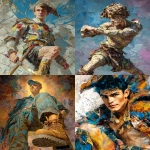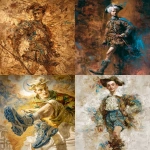Explore the Best AI Image Gallery

AI in Product Photography: The Next Frontier of Visual Storytelling
In the age of digital marketing, product photography has evolved dramatically, catalyzed by advances in artificial intelligence (AI). This innovation promises to reshape the landscape of visual storytelling while offering new tools for enhancing creativity, efficiency, and ethical considerations in photography. This blog post explores the transformative impact of AI in product photography, potential applications, ethical dilemmas, and future trends that may define the creative industry.
The Impact of AI on Product Photography
Traditionally, product photography required extensive resources, including skilled photographers, meticulous setups, and time-consuming editing processes. However, AI has streamlined many of these tasks, making it easier for businesses to produce high-quality images that resonate with consumers. Here are some notable impacts of AI on this field:
- Automated Editing Tools: Tools powered by AI can automate tedious editing tasks, such as background removal, lighting adjustments, and color corrections. This not only saves time but also ensures consistency in image quality across various platforms.
- Real-time Preview: AI enables photographers to see changes in real-time, allowing for immediate adjustments during shoots. It reduces the reliance on trial and error, enhancing productivity and optimizing results.
- Enhanced Image Generation: With the advent of generative adversarial networks (GANs), AI can create realistic product images from simple sketches or even enhance low-quality images to produce high-resolution outputs.
Potential Uses of AI in Product Photography
The versatility of AI allows its application in various facets of product photography, including:
- Dynamic Content Creation: AI can assess audience preferences and create personalized imagery that resonates with target segments, improving consumer engagement and conversion rates.
- Augmented Reality (AR): Integrating AI with AR tools allows consumers to visualize products in their environment before purchase, enhancing the shopping experience and reducing return rates.
- Image Tagging and Indexing: AI can automatically tag and categorize images based on content, facilitating easier searching and organizing of extensive product libraries.
- Social Media Automation: AI-driven platforms can manage and analyze social media campaigns, optimizing product imagery for maximum impact based on real-time data.
Ethical Considerations in AI Product Photography
While the benefits of AI in product photography are considerable, ethical dilemmas also emerge. Key concerns include:
- Authenticity: With AI’s ability to enhance and modify images, there are questions about the authenticity of product representations. Businesses need to strike a balance between appealing visuals and genuine depictions of products.
- Copyright Issues: As AI can generate images based on existing visuals, disputes over copyright and ownership may arise. Clear policies must be established to address these challenges.
- Job Displacement: As automation grows, there are fears about the potential for job loss among traditional photographers and editors. The industry must adapt to ensure that human creativity and skills remain crucial.
Future Trends in AI and Product Photography
The future of AI in product photography holds exciting possibilities. Some emerging trends include:
- Integration with E-commerce: AI-enhanced photography will become increasingly integral to e-commerce platforms, improving how consumers interact with products online.
- Predictive Analytics: AI can provide insights into emerging trends and consumer preferences, allowing brands to adapt their photography strategies proactively.
- Collaboration through AI: Photographers and AI tools will increasingly work together, combining human creativity with machine learning capabilities to create unique and engaging visuals.
- Cross-Platform Consistency: AI will help ensure that product images maintain consistency across various platforms, from social media to online stores, enhancing brand recognition.
In conclusion, AI is indeed the next frontier of visual storytelling in product photography. Its ability to streamline processes, enhance creativity, and adapt to ethical concerns presents both opportunities and challenges. By understanding and embracing these advancements, businesses can not only optimize their product photography but also engage consumers in innovative ways that align with the evolving landscape of visual media.



](https://images.ai-img.art/thumbnails/150/1614d64dd7156c95db952258978be809eb3db8cea4453fec69c49cbdfe63fa94.webp)

](https://images.ai-img.art/thumbnails/150/3a60737a5b67fa252207ad1ae6db245a26284f53fb5846996bb34515b39ff269.webp)






](https://images.ai-img.art/thumbnails/150/8c3bd422d50d35735d8fb33bd314a79e30e5b150129d5d09bdad822a2007593f.webp)